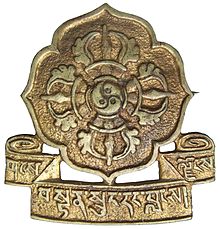- Chushi Gangdruk
-
Chushi Gangdruk (ཆུ་བཞི་སྒང་དྲུག་ Wylie transliteration: Chu-bzhi-sgang-drug, lit. "Four Rivers, Six Ranges". The full name was mdo stod chu bzhi sgang drug bod kyi bstan srung dang blangs dmag, "the Kham Four Rivers, Six Ranges Tibetan Defenders of the Faith Volunteer Army".[1] )was an organization of Tibetan guerrilla fighters who attempted to overthrow the rule of the People's Republic of China (PRC) in Tibet. The Dokham Chushi Gangdruk organization, a charity set up in New York and India with chapters in other countries, now supports survivors of the Chushi Gangdruk resistance currently living in India.[2]
Contents
Name
Chushi Gangdruk "Four Rivers, Six Ranges" is the name traditionally given to the eastern Tibetan region of Kham where the gorges of the Salween (Tib. Ngul-chu), Mekong (Da-chu), Yangtze (Dri-chu) and Yalong (Dza-chu) rivers, all arising on the Tibetan Plateau, pass between six parallel ranges of mountains that form the watersheds for these rivers. [3]
History
The formation of the Chushi Gangdruk Volunteer Force was announced on June 16, 1958. "Chushi Gangdruk" is a Tibetan phrase meaning "land of four rivers and six ranges," and refers to Amdo and Kham. The group included Tibetans from those regions of eastern Tibet, and its main objective was to drive PRC occupational forces out of Tibet. While central and western Tibet were bound by a 17-point agreement with the People's Republic of China, the PRC initiated land reform in eastern Tibet (including Kham and Amdo) and engaged in harsh reprisals against the Tibetan land-owners there.
Under the direction of General Andruk Gonpo Tashi, Chushi Gangdruk included 37 allied forces and 18 military commanders. They drafted a 27-point military law governing the conduct of the volunteers. Their headquarters were located at Tsona, then later moved to Lhagyari.
Initially militia members purchased their own weapons, mainly World War II-era British .303 in, German 7.92 mm, and Russian 7.62 mm caliber rifles. Chushi Gangdruk contacted the US government for support. However, the State Department required an official request from the Tibetan government in Lhasa, which was not forthcoming. State Department requests were made and ignored in both 1957 and 1958.
Eventually, the US Central Intelligence Agency provided the group with material assistance and aid, including arms and ammunition, as well as training to members of Chushi Gangdruk and other Tibetan guerrilla groups at Camp Hale. Chushi Gangdruk also received aid from the government of the Republic of China in Taiwan, led by Chiang Kai-shek.
From 1960, Chushi Gangdruk conducted its guerrilla operations from the northern Nepalese region of Mustang. In 1974, guerrilla operations ceased after the CIA, given the realignment of Sino-American relations initiated by President Richard Nixon, terminated its program of assistance to the Tibetan resistance movement and the Dalai Lama, the spiritual leader of the previously ruling Gelugpa, taped a message telling the Tibetans to lay down their weapons and surrender peacefully.
See also
- Tibetan American
- Tibetan Resistance Since 1950
- List of organizations of Tibetans in exile
Notes
- ^ Goldstein, Melvyn: A History of Modern Tibet. Vol. 2. The Calm before the Storm, 1951-1955, University of California Press, London, 2007, p. 598
- ^ Membership & Support
- ^ Dorje, Gyurme (2004). Footprint Tibet (3rd ed.). Bath: Footprint Handbooks Ltd.. pp. 400. ISBN 1903471303.
References
- Tsering Shakya, The Dragon in the Land of Snows - A History of Modern Tibet Since 1947, Columbia University Press, 1999, ISBN 0-231-11814-7.
External links
Categories:
Wikimedia Foundation. 2010.


